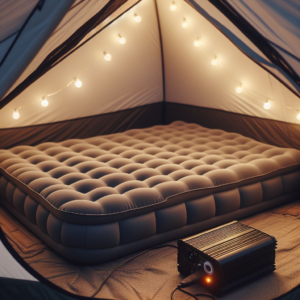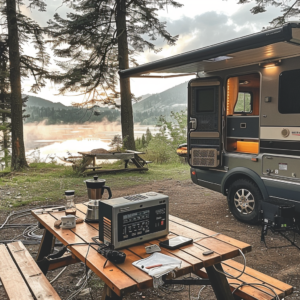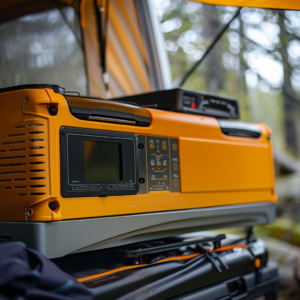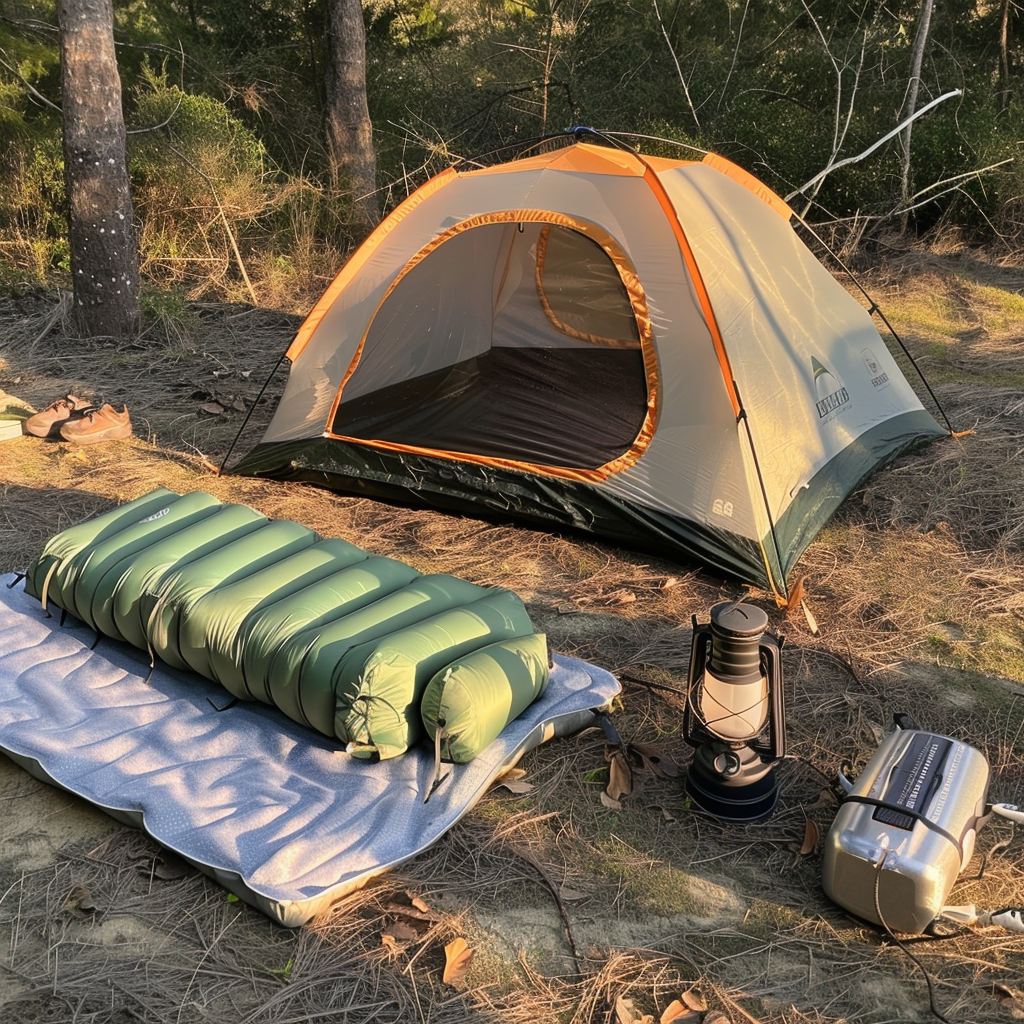If you want to elevate your camping experience and enjoy all the comforts of home while on the road, a power inverter for your camper is an absolute game-changer. Whether you’re running appliances, charging electronic devices, or operating power tools, a power inverter allows you to convert the DC power from your vehicle’s battery into AC power, providing you with the convenience of having electricity wherever you go.
With a power inverter, you can plug in and power up your favorite gadgets and appliances, making your camping trips more comfortable and enjoyable. Imagine being able to brew a fresh cup of coffee in the morning, charge your phone or camera without worrying about running out of battery, or even watch a movie on a rainy day inside your camper.
But the benefits don’t stop there. A power inverter for your camper also comes in handy during emergencies or power outages, ensuring that you always have a reliable source of electricity. So, if you’re ready to take your camping adventures to the next level and enjoy the convenience of having electricity anywhere you go, investing in a power inverter is a must-have addition to your camper.

Understanding the benefits of a power inverter
A power inverter offers a wide range of benefits for campers, making it an essential accessory for those who want to enhance their outdoor experience. One of the key advantages of a power inverter is the ability to convert DC power from your vehicle’s battery into AC power, allowing you to use standard household appliances and electronics in your camper.
Having a power inverter in your camper means you can enjoy the comforts of home even when you’re on the go. You can use it to power up your refrigerator, microwave, toaster, or even a small air conditioner. This means you can keep your food fresh, cook your favorite meals, and stay cool during hot summer days.
Additionally, a power inverter allows you to charge your electronic devices such as smartphones, tablets, laptops, and cameras. This means you can capture and share your camping adventures without worrying about running out of battery. You can also stay connected with friends and family, check weather updates, or even stream music and movies to keep yourself entertained.
In summary, a power inverter provides you with the convenience and flexibility of having electricity wherever you go. It allows you to use your favorite appliances and gadgets, making your camping trips more enjoyable and comfortable.
Types of power inverters for campers
When it comes to power inverters for campers, there are several types to choose from, each with its own features and capabilities. The two main types of power inverters are modified sine wave inverters and pure sine wave inverters.
Modified sine wave inverters are the most common and affordable option. They are suitable for powering basic appliances and electronics such as lights, fans, and small kitchen appliances. However, they may not be compatible with more sensitive electronics like laptops, TVs, or certain medical devices. It’s important to check the compatibility of your devices before choosing a modified sine wave inverter.
On the other hand, pure sine wave inverters provide a cleaner and more stable power output, similar to the electricity from the grid. They are suitable for powering all types of appliances and electronics, including sensitive devices. Pure sine wave inverters are more expensive than modified sine wave inverters, but they offer better performance and compatibility.
When choosing a power inverter for your camper, it’s important to consider the power output, input voltage, and the number of AC outlets. You should also check the surge capacity, which determines the maximum power the inverter can handle for a short period of time. Assess your power needs and select an inverter that meets your requirements.
How to choose the right power inverter for your camper
Choosing the right power inverter for your camper is crucial to ensure optimal performance and compatibility with your appliances and electronics. Here are some key factors to consider when selecting a power inverter:
- Power requirements: Determine the total wattage of the appliances and electronics you plan to power with the inverter. Add up the wattage of each device to calculate the minimum power rating you need for the inverter. It’s recommended to choose an inverter with a higher power rating to accommodate any future additions or upgrades to your camper.
- Input voltage: Check the input voltage of your vehicle’s battery and make sure it matches the input voltage range of the inverter. Most power inverters are designed to work with 12V or 24V DC systems, but it’s essential to verify the compatibility.
- Waveform: Consider the type of waveform required for your devices. If you have sensitive electronics or appliances, a pure sine wave inverter is the best option. If you only need to power basic appliances, a modified sine wave inverter may be sufficient.
- Number of outlets: Determine how many AC outlets you need. Some inverters come with multiple outlets, allowing you to power multiple devices simultaneously.
- Safety features: Look for inverters with built-in safety features such as overload protection, short circuit protection, and overheat protection. These features help prevent damage to your devices and ensure safe operation.
- Brand and reputation: Choose a power inverter from a reputable brand with positive customer reviews. This ensures you’re investing in a reliable and durable product.
Prioritize safety! Following these precautions allows you to safely reap the rewards of your power inverter during your camping trips.
Installing a power inverter in your camper
Installing a power inverter in your camper may seem daunting, but with the right instructions and tools, it can be a straightforward process. Here’s a step-by-step guide to help you install a power inverter in your camper:
- Gather the necessary tools: Before you begin, make sure you have the required tools, including a voltmeter, wire cutters, wire strippers, crimping tool, and electrical tape.
- Choose a suitable location: Find a suitable location to mount the power inverter. It should be easily accessible and well-ventilated to prevent overheating.
- Disconnect the negative battery cable: To ensure safety, disconnect the negative battery cable before starting the installation process. This prevents any accidental electrical shocks.
- Determine the cable length: Measure the distance between the battery and the inverter location to determine the length of the cable you need. Remember to account for any obstacles or curves in the wiring path.
- Select the appropriate cable size: Choose a cable with the appropriate size based on the power requirements of your inverter. Refer to the manufacturer’s guidelines or consult a professional if you’re unsure.
- Connect the cables: Strip the insulation from the ends of the cables and connect them to the appropriate terminals on the inverter. Use crimp connectors to secure the connections and cover them with electrical tape for added protection.
- Connect the negative cable: Reconnect the negative battery cable once all the connections are secure. Ensure that the cable is tightly connected to the battery terminal.
- Test the installation: Use a voltmeter to test the voltage output of the inverter. If everything is connected correctly, the inverter should provide the expected power output.
- Secure the inverter: Mount the inverter in the chosen location using the provided mounting brackets or screws. Ensure that it is securely fastened to prevent any vibrations or movement while driving.
- Double-check the connections: Before closing up the installation, double-check all the connections to ensure they are secure and properly insulated.
By following these steps, you can successfully install a power inverter in your camper, allowing you to enjoy the benefits of a reliable power source on your camping adventures.

Common uses for a power inverter in a camper
A power inverter opens up a world of possibilities for campers, enabling them to power various appliances and electronics. Here are some common uses for a power inverter in a camper:
- Kitchen appliances: With a power inverter, you can power kitchen appliances such as a microwave, toaster, blender, or coffee maker. This allows you to prepare meals and enjoy your favorite beverages while on the road.
- Entertainment devices: A power inverter allows you to power entertainment devices such as a TV, DVD player, gaming console, or portable projector. You can turn your camper into a mini theater and enjoy movies, shows, or gaming sessions during downtime.
- Charging electronic devices: Keep your smartphones, tablets, laptops, cameras, and other electronic devices fully charged with a power inverter. This ensures you stay connected, capture memories, and have access to information while on your camping trips.
- Medical equipment: If you have medical equipment that requires electricity, such as a CPAP machine or a nebulizer, a power inverter is essential to ensure uninterrupted power supply. This allows you to manage existing health conditions even while camping.
- Power tools: If you need to use power tools for repairs or DIY projects during your camping trips, a power inverter can provide the necessary electricity. This makes it easier to perform tasks without relying on external power sources.
Invest in your inverter’s longevity! Proper care and timely troubleshooting will help it power your camping trips for years to come.
Tips for maximizing the benefits of a power inverter
To make the most out of your power inverter and ensure optimal performance, consider the following tips:
- Manage power consumption: Be mindful of the power requirements of your appliances and devices. Avoid simultaneously running high-power devices that may exceed the inverter’s capacity.
- Invest in energy-efficient appliances: Opt for energy-efficient appliances that consume less power. This allows you to make the most out of your power inverter and extend your battery life.
- Monitor your battery levels: Keep an eye on your vehicle’s battery levels to avoid draining it excessively. Consider investing in a battery monitor or using a portable solar panel to recharge your battery.
- Secure your connections: Regularly check the connections between your power inverter, battery, and appliances to ensure they are secure and free from corrosion. Loose connections can lead to power interruptions or damage to your devices.
- Follow the manufacturer’s guidelines: Read and follow the manufacturer’s instructions and guidelines for operating and maintaining your power inverter. This ensures safe and optimal usage.
- Carry spare fuses: Keep spare fuses in your camper in case of any blown fuses. This allows you to quickly replace them and resume power supply.
Unlock your inverter’s full potential! Follow these practices to ensure a dependable power source during your outdoor adventures.

Maintaining and troubleshooting your power inverter
Proper maintenance and troubleshooting are essential to ensure the longevity and optimal performance of your power inverter. Here are some maintenance tips and troubleshooting techniques:
- Regular cleaning: Keep your power inverter clean by removing any dust or debris that may accumulate on the surface or vents. Use a soft cloth or a brush to gently clean the inverter.
- Inspect for damage: Regularly inspect your power inverter for any signs of damage, such as loose connections, frayed wires, or physical damage. Address any issues promptly to prevent further damage or safety hazards.
- Check the battery: Monitor your vehicle’s battery to ensure it is in good condition and holds a charge. A weak or faulty battery can affect the performance of your power inverter.
- Keep an eye on the indicators: Pay attention to the indicators on your power inverter. If any warning lights or error codes appear, consult the user manual or contact the manufacturer for troubleshooting steps.
- Refer to the user manual: Always refer to the user manual for specific maintenance instructions and troubleshooting tips provided by the manufacturer. Following their guidelines ensures proper care and operation of your power inverter.
- Consult a professional: If you encounter any complex issues or are unsure about troubleshooting steps, seek assistance from a professional technician or the manufacturer’s customer support.
Get the most out of your inverter! These tips will help you optimize its use for convenient power on your camping trips.
Power inverter safety precautions for campers
While power inverters provide numerous benefits, it’s essential to follow safety precautions to prevent accidents and ensure safe operation. Here are some important safety tips to keep in mind:
- Read the user manual: Familiarize yourself with the user manual and manufacturer’s instructions before operating your power inverter. Understanding its features, limitations, and safety guidelines is crucial for safe usage.
- Proper ventilation: Ensure that your power inverter has sufficient ventilation to prevent overheating. Avoid enclosing it in tight spaces or covering the vents.
- Secure connections: Make sure all connections, including battery terminals and appliance plugs, are secure and properly insulated to prevent short circuits or electrical shocks.
- Avoid overloading: Do not exceed the power capacity of your power inverter. Overloading can cause overheating, damage to the inverter or devices, and even pose a fire risk.
- Use surge protectors: Consider using surge protectors to safeguard your appliances and electronics from voltage spikes or power surges.
- Keep flammable materials away: Keep flammable materials away from your power inverter to prevent fire hazards. Ensure the inverter is installed in a location free from combustible materials.
- Turn off when not in use: When not in use, turn off your power inverter to conserve battery power and reduce the risk of accidental electrical discharge.
- Regular maintenance: Regularly inspect and maintain your power inverter as mentioned earlier to identify and address any potential safety concerns.
Find the perfect power solution! Consider these factors when choosing a power inverter that matches your camper’s needs.
Conclusion: Enjoying the convenience and flexibility of a power inverter in your camper
A power inverter might seem like a luxury, but for savvy campers, it’s a worthwhile investment. The freedom to use those familiar creature comforts and essential electronics makes your adventures less about roughing it and more about fully enjoying the natural world on your own terms. Whether it’s the simple pleasure of hot coffee in the wilderness or the security of knowing your medical devices will always have power, a power inverter unlocks new possibilities.
Before hitting the road, consider your power needs, choose the right inverter, and prioritize safe installation. Once you’re set up, the convenience of home-style electricity will have you wondering how you ever camped without it. So, next time you pack up your camper, be sure to include a power inverter – it’s the gadget that might just transform your entire camping experience.


Leave a Reply